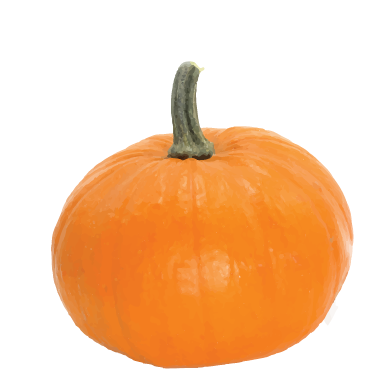Eat Smart, Move More at Farmers Markets: Pumpkins
ID
HNFE-320-16NP

Key Points
- An excellent source of vitamin A. Contains carotenoids that may be good for health.
- Select pumpkins that are firm and heavy for their size.
- Wash hands with warm water and soap for at least 20 seconds before and after handling fresh fruits and vegetables.
- Store pumpkins in a cool, dark place for up to two months.
Pumpkin for Cooking
Ingredients:
1 pumpkin
Directions:
- Heat oven to 375°F.
- Cut the pumpkin in half and discard the stem section and stringy pulp.
- In a shallow baking dish, place the two halves cut-side down and cover with foil.
- Bake for about 90 minutes for a medium-size sugar pumpkin, or until tender.
Honey of a Pumpkin Bar
Number of servings: 15
Ingredients:
Nonstick cooking spray
1/3 cup nonfat dry milk
2 cups whole-wheat flour
1 teaspoon baking soda
1 1/2 tablespoons apple pie spice
2 eggs
1 cup baked, pureed pumpkin
2/3 cup honey
1/2 cup orange juice
1/3 cup canola oil
Directions:
- Heat oven to 350°F. Spray a 9-by-13-inch baking pan with nonstick spray.
- In a large bowl, combine dry milk, flour, baking soda, and apple pie spice. Set aside.
- In a medium bowl, add eggs, pumpkin, honey, juice, and oil, mix well.
- Gradually add pumpkin mixture to flour mixture, stirring until smooth.
- Spread batter in prepared baking pan. Bake at 350°F for 15-20 minutes, or until golden brown and cake springs back when lightly touched with your finger.
- Allow to cool. Cut into squares.
Per serving: 172 calories; 6 g fat (1 g saturated fat); 4 g protein; 28 g carbohydrate; 2 g dietary fiber; 29 mg cholesterol; 110 mg sodium.
Crustless Pumpkin Pie
Number of servings: 8
Ingredients:
Nonstick cooking spray
4 eggs
2 cups baked, pureed pumpkin
8 ounces evaporated milk
1/2 teaspoon salt
3 teaspoons pumpkin pie spice
1 teaspoon vanilla
2/3 cup sugarl
Directions:
- Heat oven to 400°F. Spray a 9-inch pie pan with nonstick cooking spray.
- Using a mixer, beat eggs. Add pumpkin, evaporated milk, salt, pumpkin pie spice, vanilla, and sugar. Mix until smooth.
- Pour into pie pan and bake at 400°F for 15 minutes.
- Turn oven down to 325°F and bake for another 45 minutes. Pie is done when knife inserted in center comes out clean.
Per serving: 151 calories; 5 g fat (2 g saturated fat); 5 g protein; 22 g carbohydrate; trace dietary fiber; 114 mg cholesterol; 199 mg sodium.
Quick Tips
- Pumpkins are not just for carving. Add pumpkin to pancakes, muffins, and even savory dishes like soups.
- Replace applesauce with pumpkin puree in your favorite apple-bran muffin recipe.
- Clean pumpkins and other firm-skinned produce under running tap water while rubbing with your hands or scrubbing with a clean brush.
- Eat the seeds too! Heat oven to 350°F. Toss seeds with a drizzle of olive oil, salt, and pepper. Roast seeds for 30-45 minutes, tossing every 10 minutes. Try spicing them up with cinnamon.
This institution is an equal opportunity provider. In accordance with Federal law and U.S. Department of Agriculture (USDA) civil rights regulations and policies, this institution is prohibited from discriminating on the basis of race, color, national origin, sex, age, disability, and reprisal or retaliation for prior civil rights activity. (Not all prohibited bases apply to all programs.) This material was partially funded by USDA’s Supplemental Nutrition Assistance Program – SNAP – and the Expanded Food and Nutrition Education Program (EFNEP). SNAP is funded by the U.S. Department of Agriculture Food and Nutrition Service and the Expanded Food and Nutrition Education Program (EFNEP) is funded by the U.S. Department of Agriculture, National Institute of Food and Agriculture (USDA/NIFA).
Virginia Cooperative Extension materials are available for public use, reprint, or citation without further permission, provided the use includes credit to the author and to Virginia Cooperative Extension, Virginia Tech, and Virginia State University.
Virginia Cooperative Extension is a partnership of Virginia Tech, Virginia State University, the U.S. Department of Agriculture (USDA), and local governments, and is an equal opportunity employer. For the full non-discrimination statement, please visit ext.vt.edu/accessibility.
Publication Date
February 8, 2021



